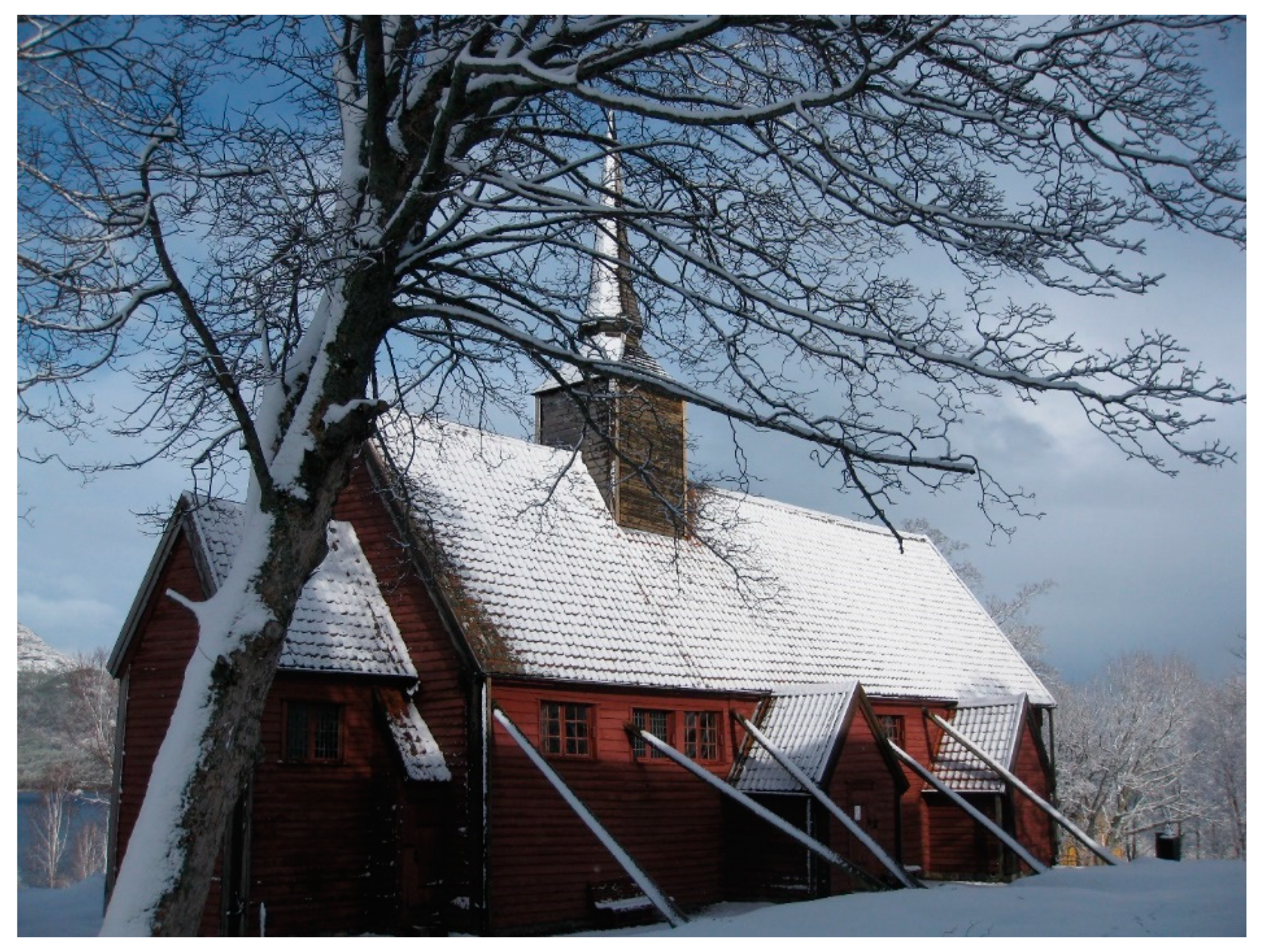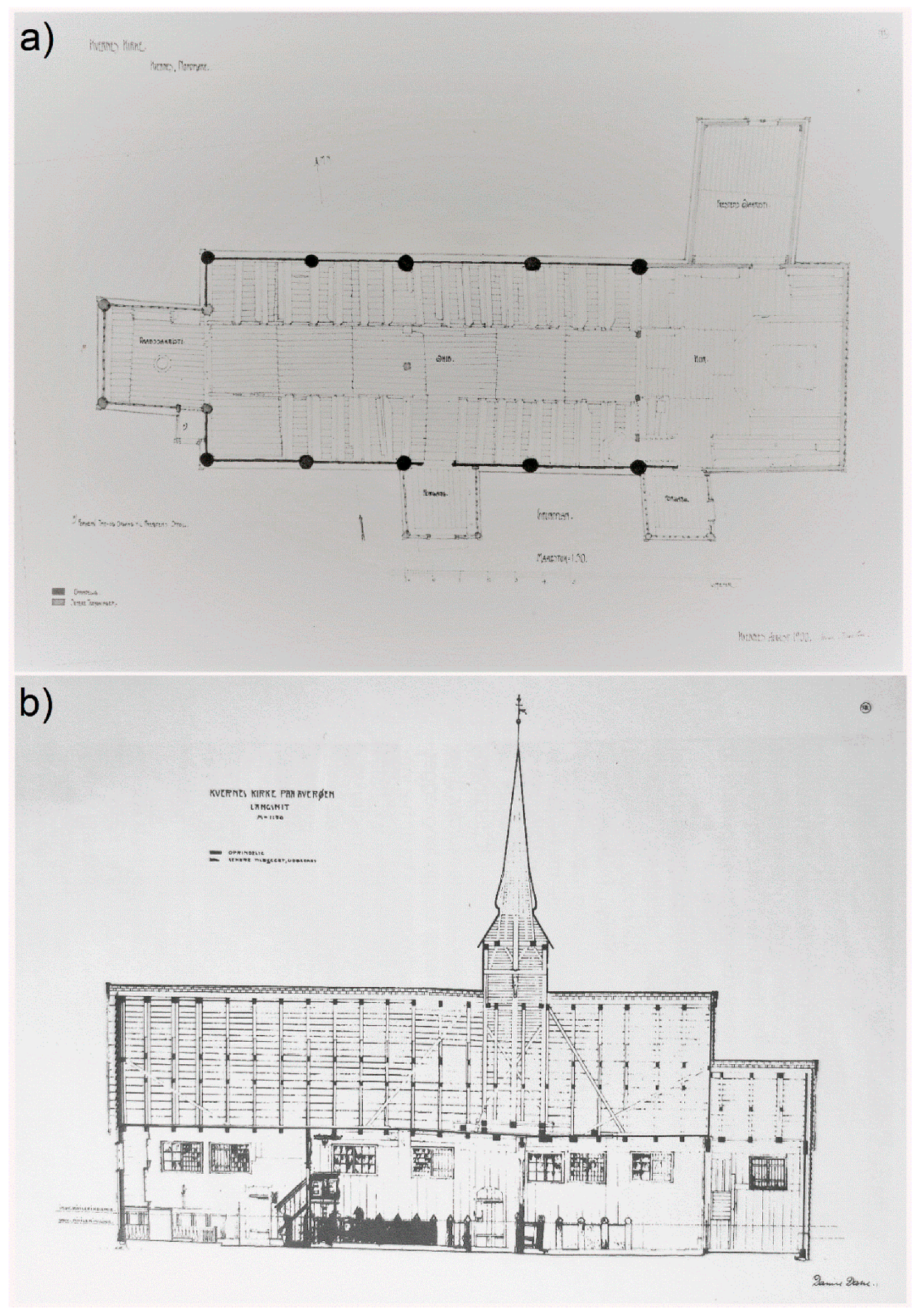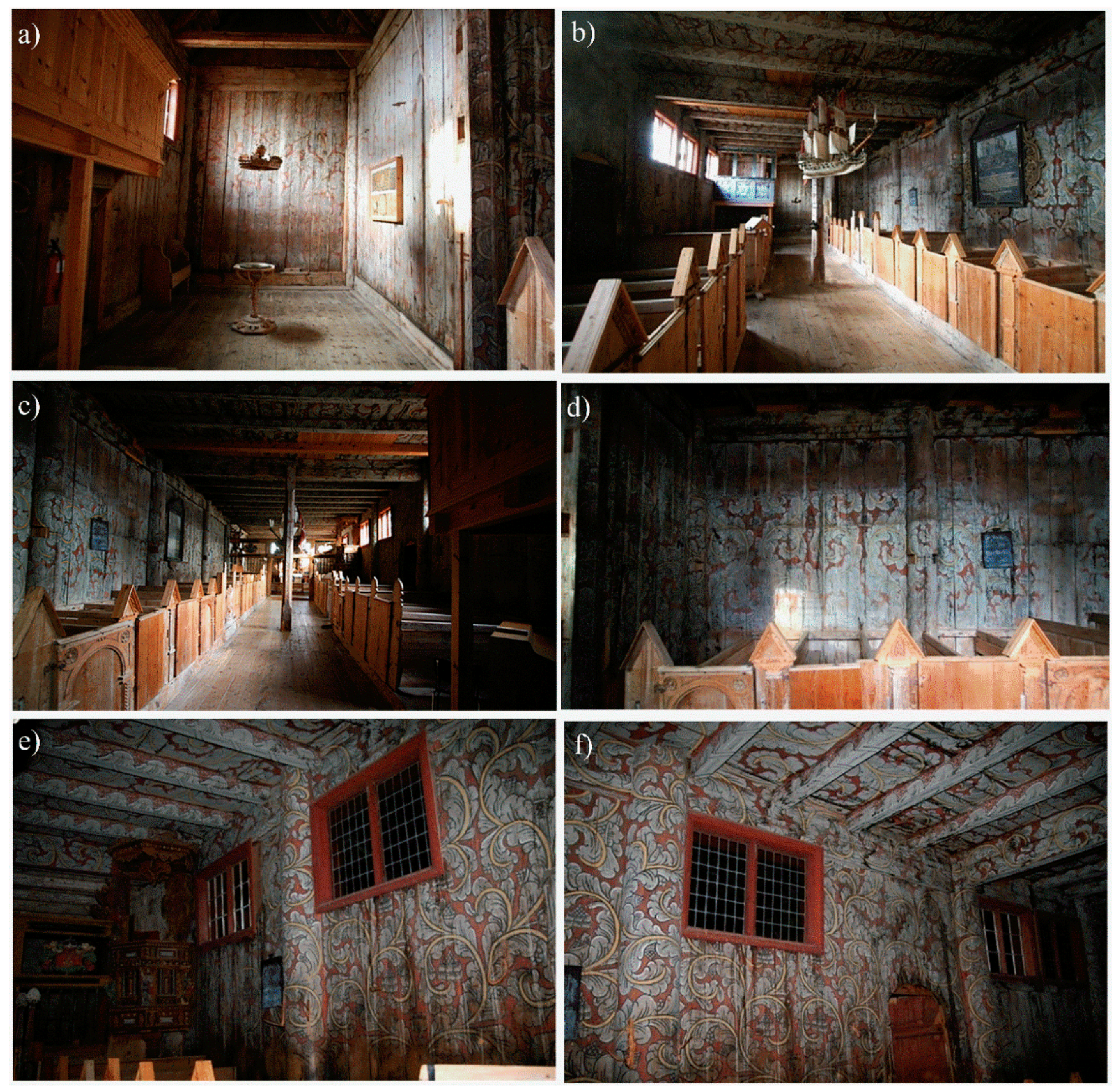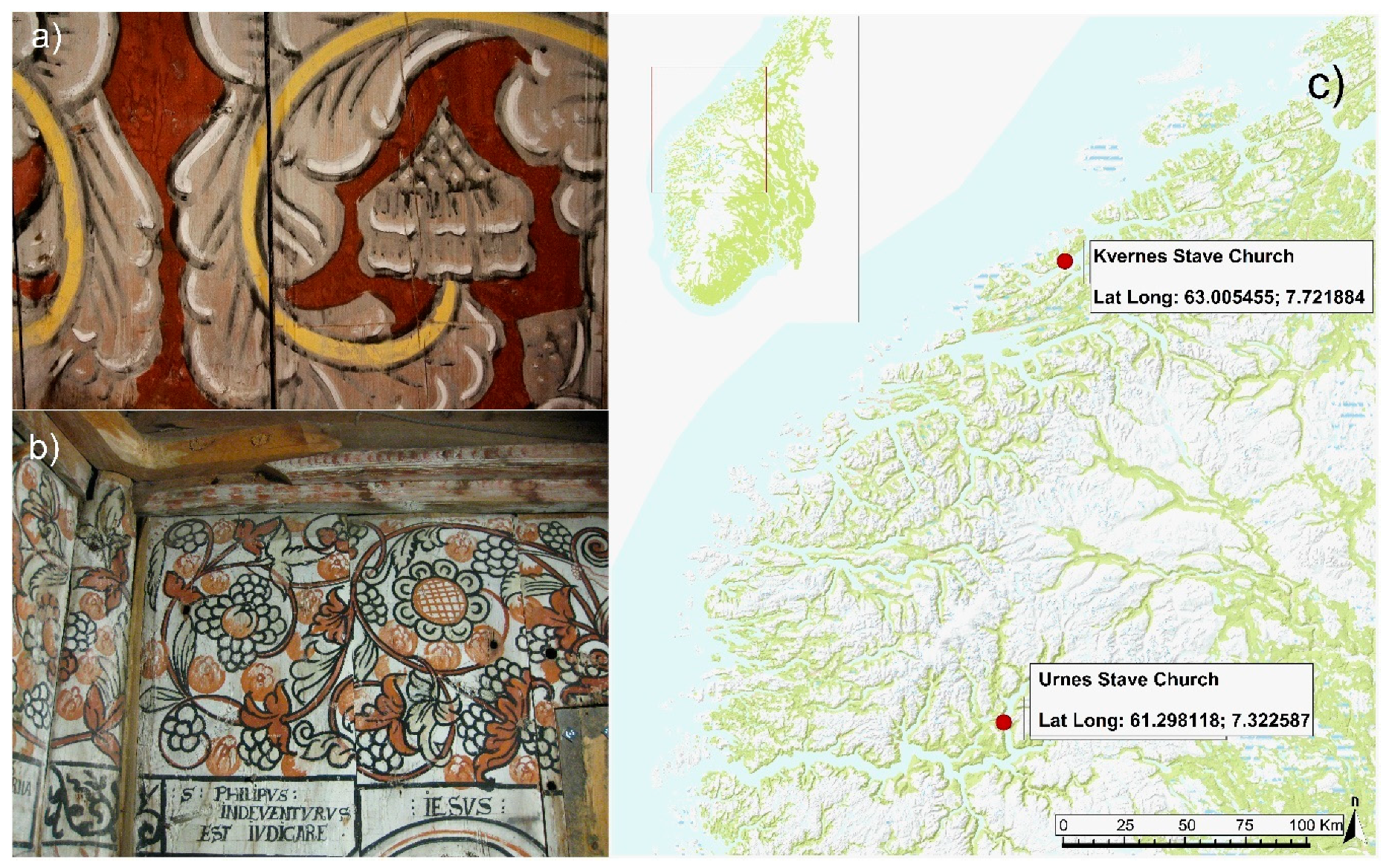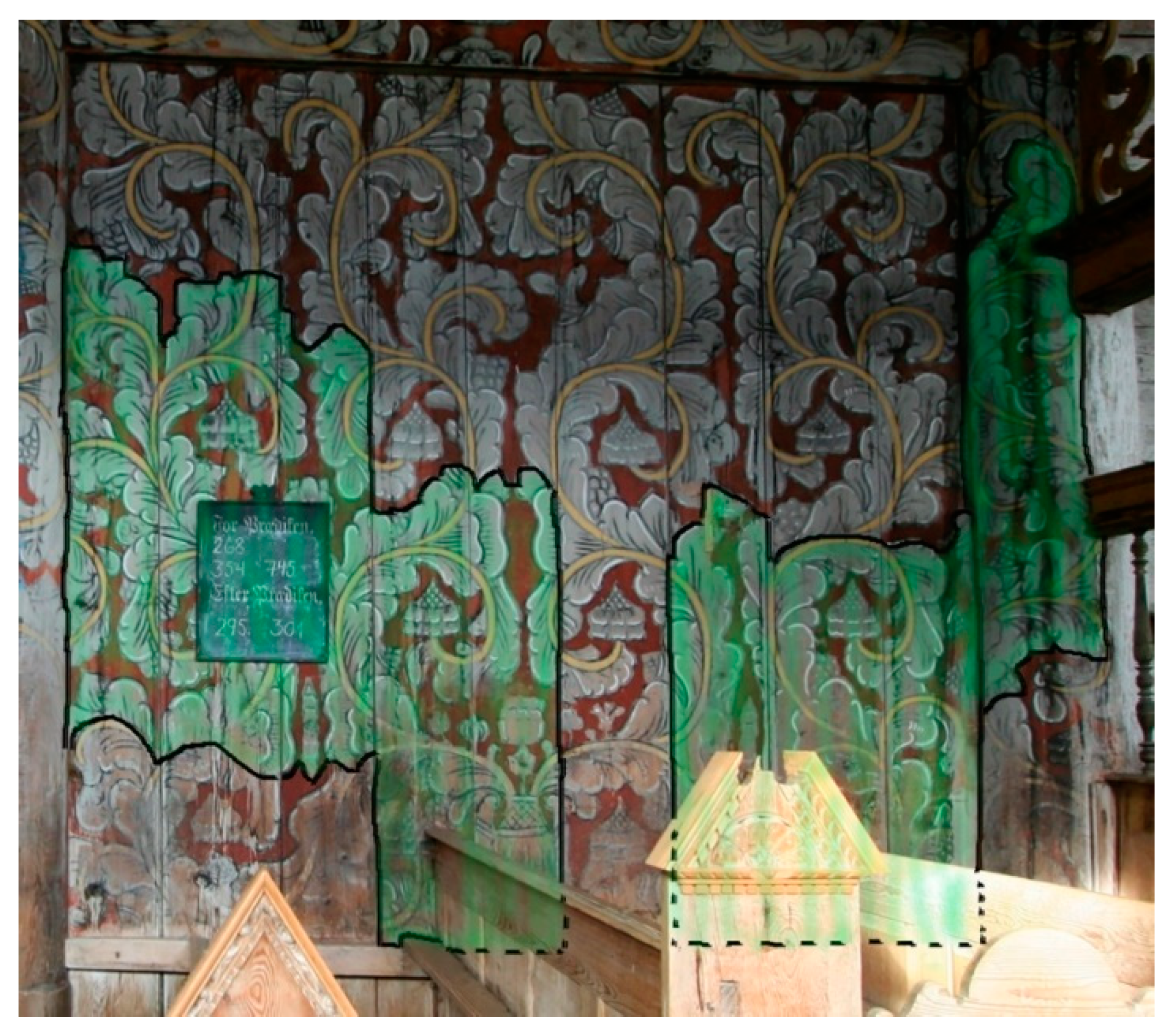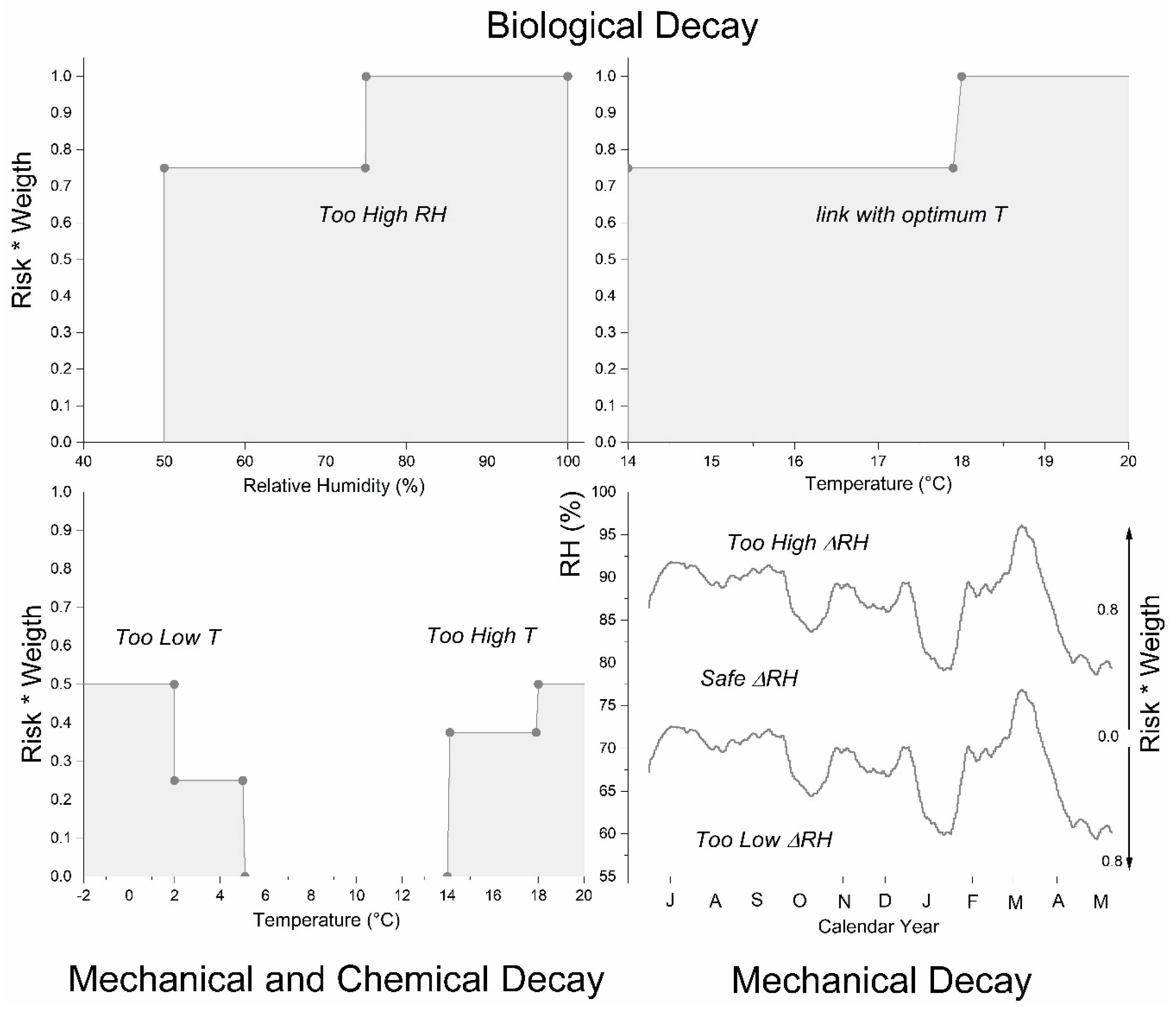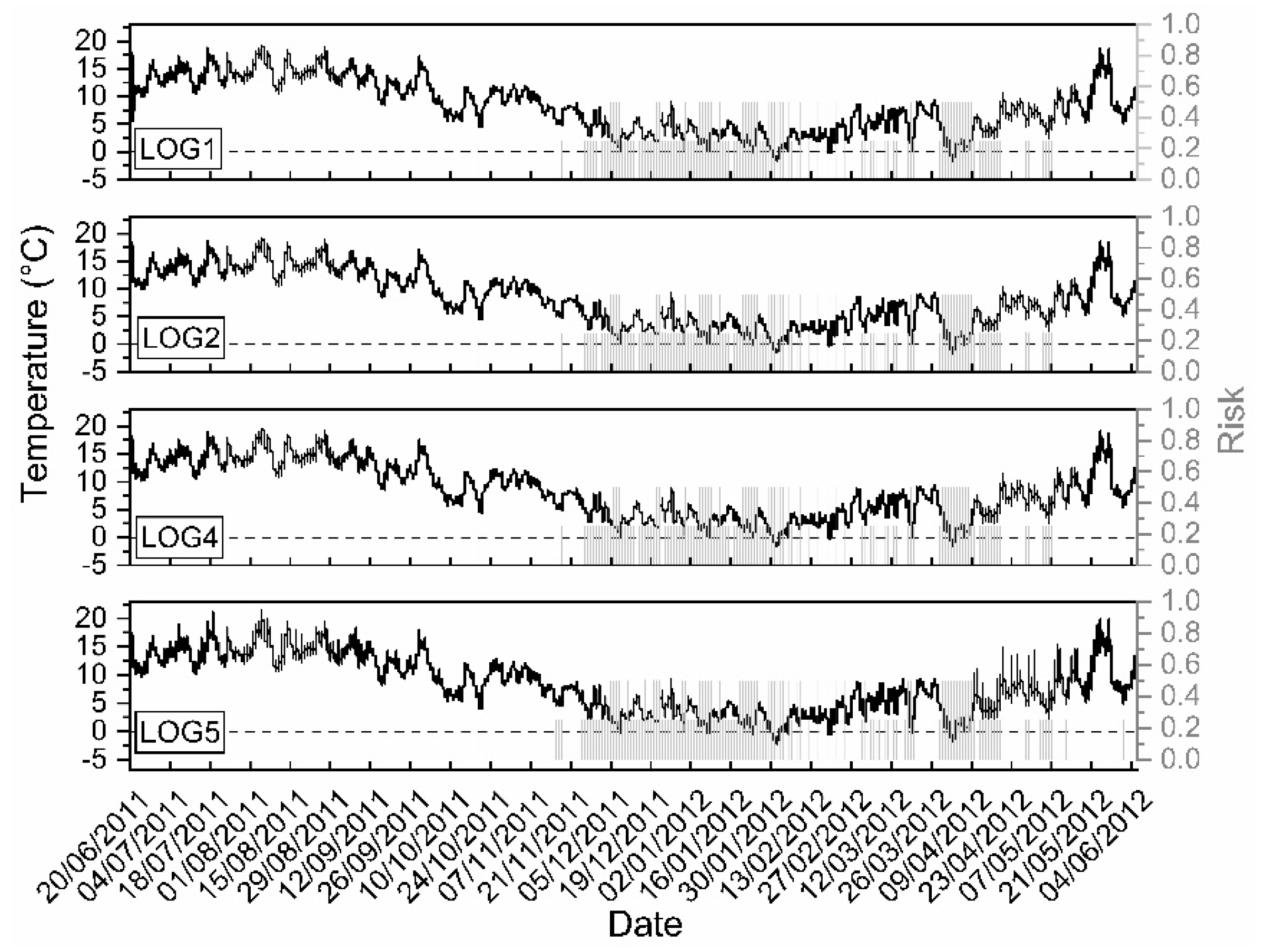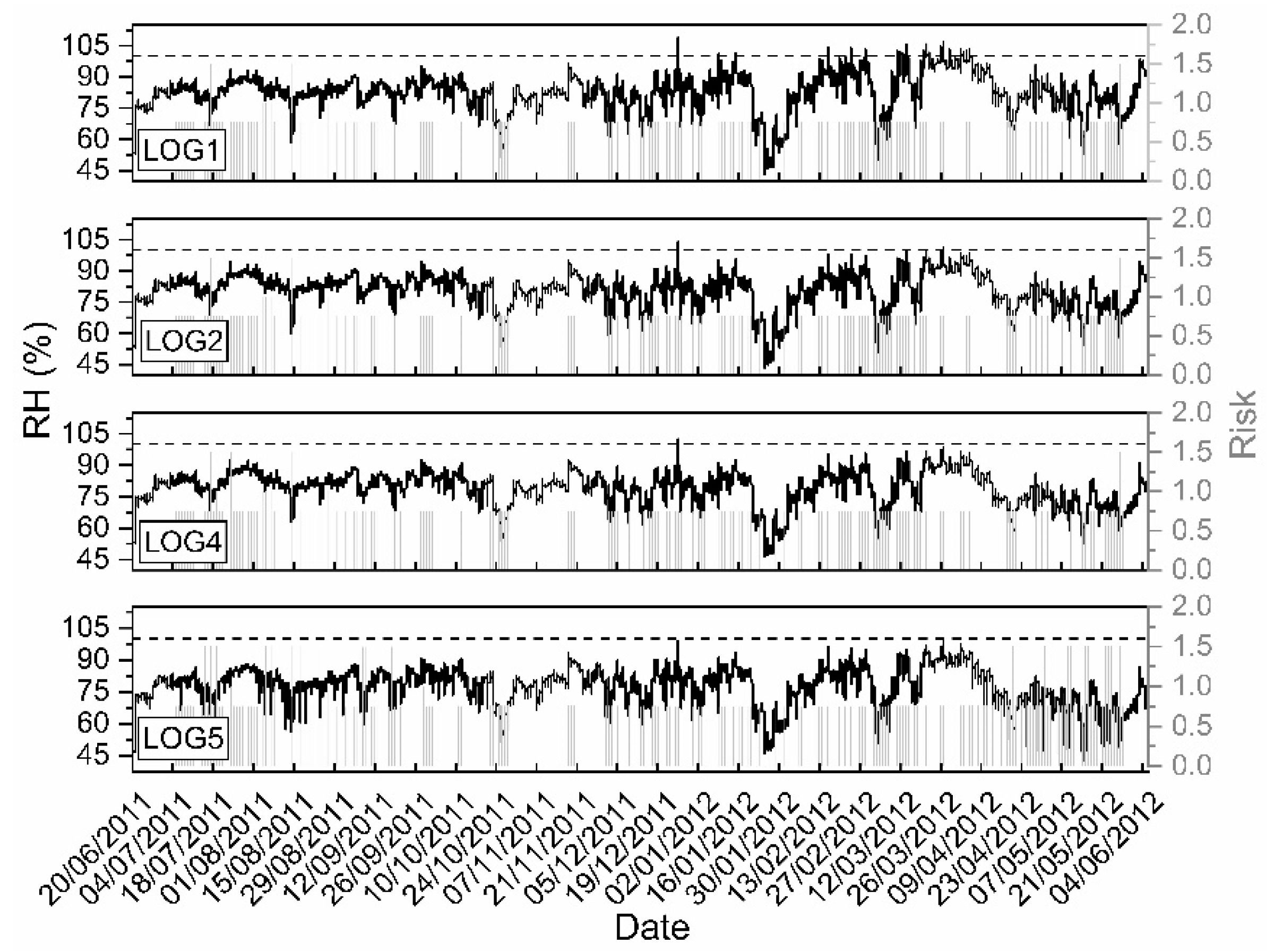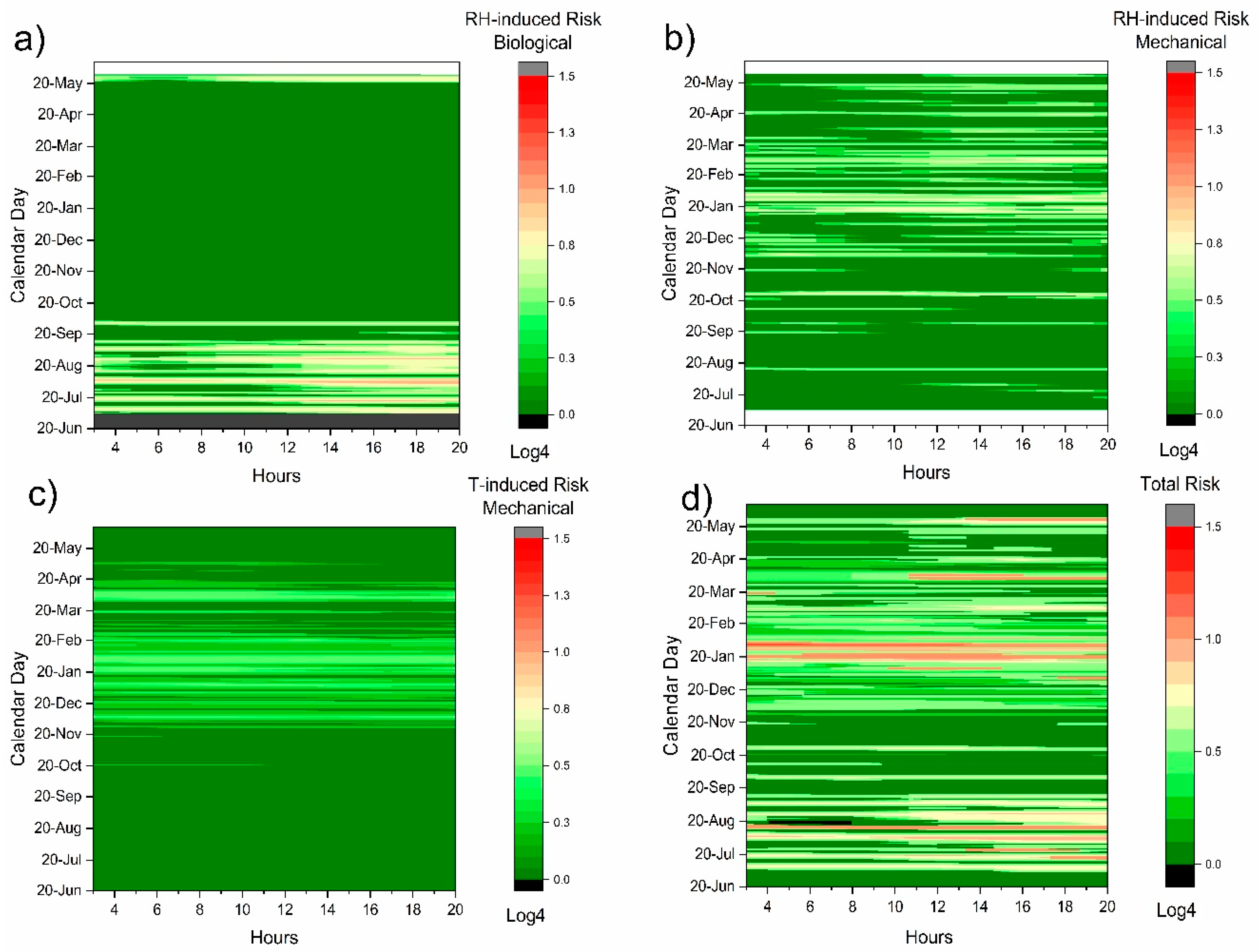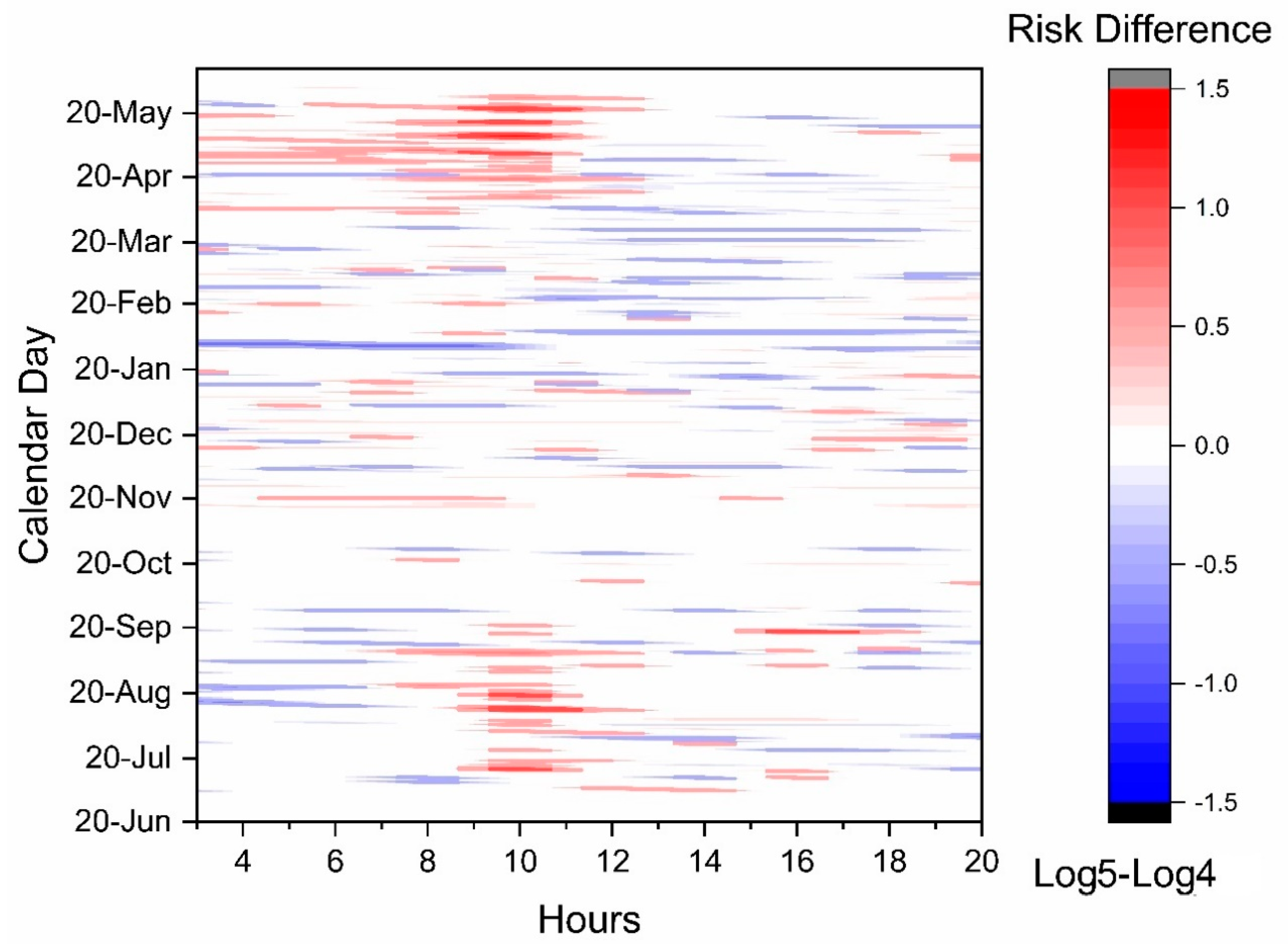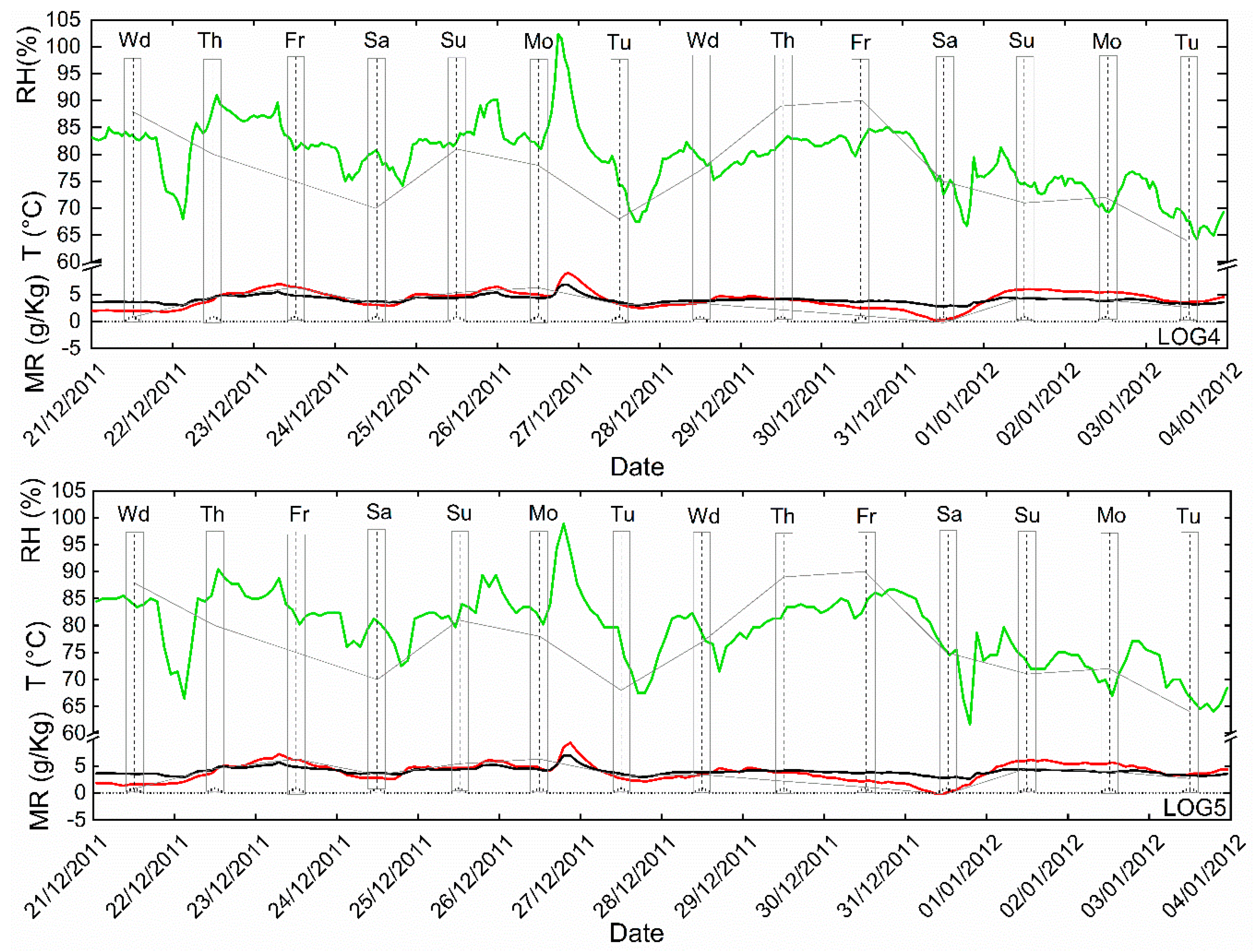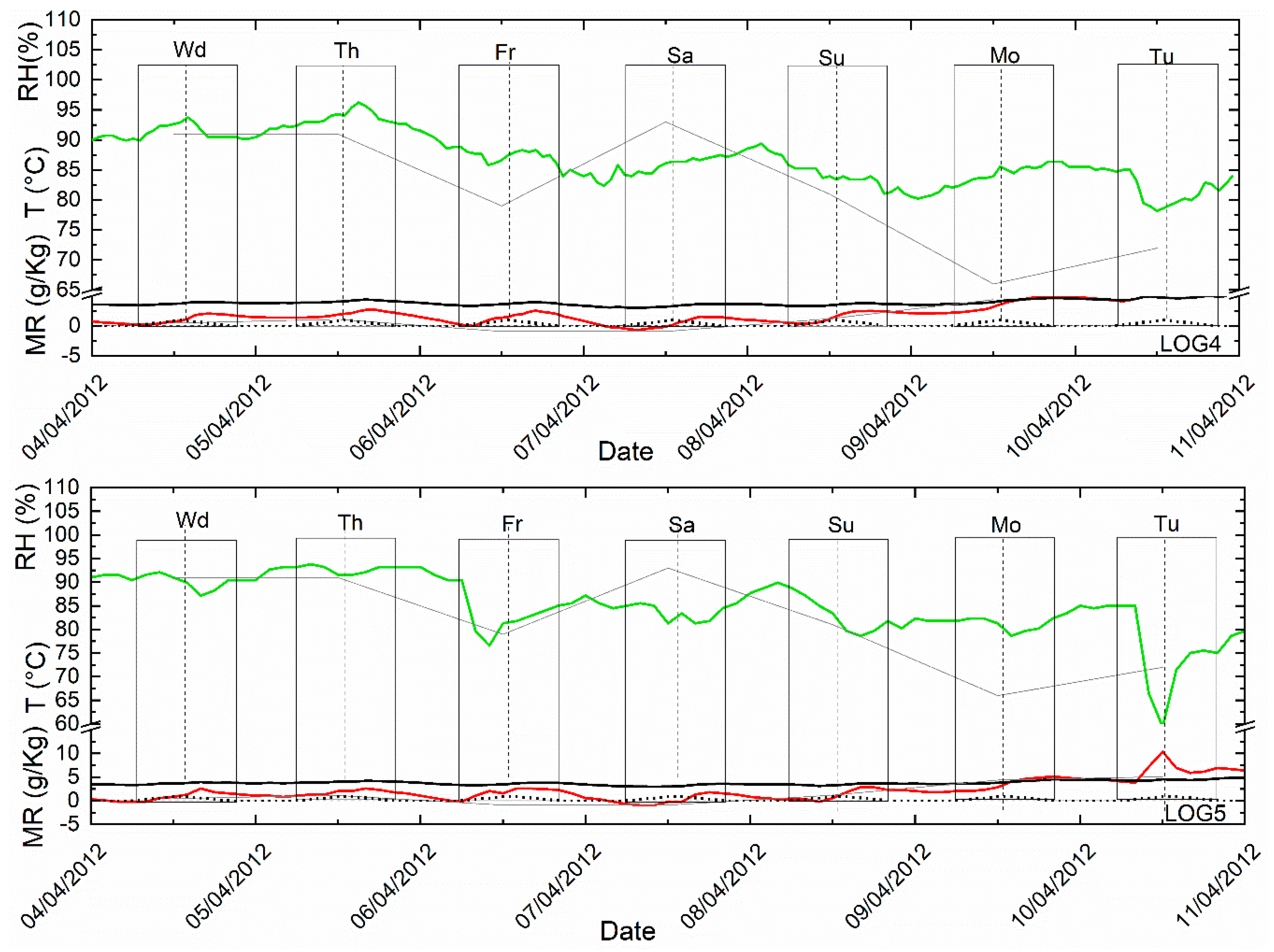1. Introduction
The indoor microclimate of cultural heritage sites, especially churches which have forgone any type of comfort heating system, are directly governed by the external climate. The climate affects the structure based on the structure’s dimension, internal partition, and building materials [
1]. In historic churches, high relative humidity (RH) and low temperature (T) values are often found [
2,
3], making the indoor environment uncomfortable for visitors and patrons. To improve comfort for users, many sites installed heating systems in the 20th century [
4]. However, this was not the case for Norwegian churches which started to install heating systems in the 19th century; some even well before 1897 when a law imposed the mandatory heating of churches. Newer heating systems were installed in most churches during the 20th century [
5].
Many Norwegian churches are currently heated using two different practices: the churches are either heated only during the winter months, and left unheated during the summer, or they are only heated during services. The main consequence of these two practices is induced variations in the church’s indoor climate (i.e., relative humidity as well as temperature) [
4]. However, this is not the case for Kvernes stave church which has been maintained in its original condition since its construction and is still without a heating system. A possible reason why a heating system was never installed in Kvernes is because a new church was erected in 1893, replacing the original stave church which was no longer in ordinary use.
In the last decade or so, the effects of climate-induced change have become more and more evident in many scientific fields, including the cultural heritage field. Quick and erratic climatic variations are creating new conservation challenges. Challenges related to effective risk assessment of sites may include long-term monitoring plans coupled with analytical campaigns that are able to concurrently detect the conservation state of all the materials existing in a historic building. These risk assessments, recently in association with tools allowing the simulation of current or future scenarios, permit the creation of the most appropriate strategies for the management of monuments [
6]. Conventional museums and archives’ environmental set points are hard to follow when approaching the management of temperature and relative humidity conditions of historic churches [
4], including unique wooden structures such as stave churches. There are key parameters which need to be taken into consideration when proposing a strategy to control indoor microclimate and its risk assessment. For stave churches these parameters include the construction methods and material, the decorative parts of the interior, the protocol for use of a heating system in churches as well possible conflicts when installing heating, ventilation and conditioning (HVAC) systems to control the indoor climate. These parameters are the foundation for conservation and adaptation strategies, with regards to predicting the effects of indoor climate change.
The primary aim of this paper is to present the typical indoor conditions resembling historic climate information for stave churches. In particular, this paper will use Kvernes stave church as a case study for unheated Norwegian wooden churches, since it is preserved in its natural microclimate and not perturbed by a heating system. Secondly, this paper intends to present the characteristics of one of the most climate-sensitive materials preserved within a stave church—distemper paint—and more precisely distemper paint in Kvernes stave church which is not changed or “distorted” by overpainting, removal of overpaint or unsuitable consolidation treatments. In general, it is assessed to have been left untouched until certain painted areas on the walls were consolidated with sturgeon glue in 2013. Finally, this paper aims to introduce an effective standardized risk assessment tool [
7] to the cultural heritage field to better manage the climate-induced decay of this sensitive object.
The research presented in this paper is a preliminary outcome of the International Research Project SyMBoL or Sustainable Management of Heritage Building in a Long-term Perspective (2018–2021) coordinated by the Norwegian University of Science and Technology (NTNU) and funded by the Research Council of Norway. The SyMBoL project aims to contribute to the debate on appropriate environmental conditions for preserving the 28 remaining Norwegian stave churches and their distemper decorative paint in a time of climate change and mass tourism.
1.1. Stave Churches and Distemper Decorative Paint
Distemper paintings are found in 19 of the 28 preserved stave churches in Norway. Most of the paintings are from the 17th and 18th centuries and are typically dominated by tendrils and vines, which often cover the entirety of the churches’ interior. Seven of these 19 churches have distemper paintings, or fragments of paintings, from the 1200s (Torpo, Rollag, Nore, Hopperstad, Hedalen, Heddal, and the Høyjord; only the paintings in the Torpo stave churches are visible to the visitors) [
8] (p. 69). Over the centuries, the artistic and cultural importance of these paintings have varied. Specifically, at the end of the 19th century, some of these decorative paint layers were deliberately washed off the church walls [
8] (p. 71). However today these paintings are given high cultural and historic value, and the conservation of these paintings are now an integral part of conserving stave churches.
1.2. Kvernes Stave Church
Kvernes stave church is located on the west coast of Norway, in a coastal climate characterized by high relative humidity throughout the year and mild winters. The church is in Møre and Romsdal county, which happens to be one of Norway’s top two counties most often impacted by extreme stormy weather [
9]. The church is situated in a clearing, about 200 m from the fjords, completely exposed to the elements (
Figure 1). After a hurricane in 1992, structural work was needed to prevent horizontal movement. In addition, the church has had continuous problems with water and moisture, both due to a leaky roof and moisture in the ground. As a result of these moisture issues, wood rot is a concern. In the hopes mitigating wood rot, the terrain around the church was lowered in the 1930s, reducing the amount of groundwater which could damage the wooden structure [
10]. Even with these preventative measures, when examining the predicted climate towards the year 2100, there is an expected increase in average temperature of 2.0–2.5 °C, and the amount of rain is expected to increase by 25%–30%. In addition, more wind is also anticipated [
10] (p. 13).
Kvernes is a single-nave church owned by the Society for the Preservation of Ancient Norwegian Monuments. It is nominally 16 m long and 7.5 m wide and seats up to 200 people (
Figure 2). New research, carried out in 2019, might even date the structure of the church to as early as the 1600s [
11] (p. 22). The entire exterior, except for the eastern wall, was cladded most likely during the mid-17th century. The interior, to date, is dominated by decorative paintings from the 1630s (
Figure 3). These decorative distemper paintings completely cover the walls and ceiling in both the chancel and nave (
Figure 3b,c), as well as the baptistery (
Figure 3a) in the western end of the nave. Between the nave and the chancel is a screen composed of a dado (i.e., chair rail) under a row of turned balusters carrying horizontal moldings in two layers. King Christian VI’s carved and painted monogram is centrally placed over the opening of the chancel. On each side of King Christian VI’s monogram, one will find carved and painted coats of arms and a polychrome crucifix (ca. 1630s) hanging above the monogram. Connected with the screen, on the south wall, there is a carved and painted pulpit (ca. 1630s). In the chancel, a large, carved and painted polychrome epitaph (1671) dominates the northern wall. Resting on top of the wooden painted altar, is an altarpiece with a late Medieval triptych built into a carved and painted 17th century altarpiece (1695). On the nave’s southwest wall, there is a small decorated gallery for the priest’s family.
1.3. Distemper Paintings: Its Characteristics and Treatment
Distemper paint is a water-based material made from pigments mixed with animal glue as the main binder. However, analyses of 17th century paintings revealed that casein, egg, and oil are sometimes added to the glue binder [
12]. Analyses carried out at the end of the 1990s identified casein or egg, however, this has yet to be confirmed by later studies. Furthermore, analyses performed as part of the Stave church preservation program, detected oil in some decorations dating back to the 1600s. It is uncertain whether this is due to a later treatment, or if oil was added to the glue as a binder. Analyzing glue as a protein-containing binder is complicated. The protein composition is specific for each type of glue and the proteins are defined by the combination of amino acids for each individual protein. In spite of several analysis methods used, in parallel, the chances of incorrect interpretation are high, and the amount of glue may be too small for the analysis instruments to detect.
The portions of binder to pigment in the distemper paint must be prepared in such a way that the paint neither runs down the wall whilst still wet, nor rubs off after drying. Distemper paintings are characterized by a porous, usually matte, surface.
Artists’ exact process for painting decorative wall paintings in stave churches is unknown, however, through observation, analysis, and literature review, key concepts of artists’ technique are elucidated. The painters did not put much effort into having the woodworkers prepare a smooth wooden surface to paint upon, as tool marks are often seen through the paint layers. However, the surface may have been primed with glue before the base paint was applied. A sketch on the base layer of paint, and the use of a compass and etched lines were observed in several distemper paintings from the 1600s. In post-Reformation distemper decorative paintings, the distinct local colors of the elements are painted on the surface of the dry background color, which was usually white; then any shadowing or colors that add shape, and finally the contours were painted. Color details could be added after the contouring. The paintings in the nave and baptistery in Kvernes stave church follow this general painting method (
Figure 4).
Due to the matte and porous surface of distemper paint, very few methods and materials are suitable for conserving these paintings, if the main goal is to keep the appearance of the surface unchanged [
13]. In 1984 the Directorate for Cultural Heritage (DCH) initiated a registration of distemper decorative paints in stave churches [
14]. Subsequently, in 1989, the testing of different consolidation methods for distemper decorative paints was undertaken during the conservation treatment of the décor in Uvdal stave church (latitude: 60.26° N; longitude: 8.83° E) [
15]. This test favored sturgeon glue, over many others, including, Klucel (hydroxypropylcellulose) and gelatin [
16]. The conservators at the DCH, and later conservators at the Norwegian Institute for Cultural Heritage Research (NIKU), have since used sturgeon glue as the main consolidant for distemper paint [
17]. The last consolidation treatment executed with sturgeon glue, in a Norwegian stave church, was in 2013 at Kvernes stave church. The preservation of distemper paint in churches is a constant area of interest for NIKU, and projects have concentrated on 16th and 18th century distemper decorative paintings [
18]. Additional information was gained when the Stave Church Preservation Programme (2001–2015) provided an opportunity to work with several distemper decorative wall paintings that needed treatment: three Medieval distemper decorative paintings and 12 post-Reformation distemper decorative paintings in 14 stave churches were examined and treated [
8].
An assessment of these treated paintings was made in 2013-2014. In several cases, the paint was found to lack proper adhesion to the underlying support; this was also found for those which were treated just a few years earlier. The examination was a follow-up of the assessment of consolidation methods for distemper decorative paints, as an answer to the constant need for greater knowledge on sturgeon glue as a consolidation material, and more specifically, for understanding which parameters are essential for successful results in consolidation treatments. In addition, the survey of conservative conditions of decorative distemper painted surfaces was also implemented in another recent project: “Environmental monitoring of the impact of climate change on protected buildings” started in 2017 and coordinated by NIKU [
6]. An example of the mapping of conservation treatments obtained by the survey inside Kvernes stave church is depicted in
Figure 5.
2. Materials and Methods
2.1. Conservation Investigation of Distemper Paintings
In
Section 2, the preservation state of the distemper paintings in the nave and baptistery of Kvernes is related to research and practical experience from the conservation of distemper paintings in a number of other stave churches. However, because the paintings in the chancel of Kvernes are so heavily altered by overpainting and conservation treatments, these paintings are not discussed in this paper. As for the nave, there are no indications of earlier treatment carried out on the distemper paintings. In general, signs of damage are related to wear and tear and long-term water leakages. The paintings are worn and unbound, and flaking paint was registered in 2012; however, the condition of the walls varies from area to area. This paper will only focus on distemper paint which was not heavily altered by previous conservation treatments.
In the case of Kvernes today, there are between 12,400 and 15,300 visitors a year, with an increasing number in the last four years. Usually two tourist buses arrive daily in the period April–September, in addition to tourists who travel by cruise in the period June–August. During these mass visits, the church administration only allows a maximum group of 90 visitors inside the church at a time (amount of visitor in the years 2016–2019, internal communication with Sørvik, A.K. Head of management Kvernes stave church. Email correspondence, 2 December 2019).
When assessing the current condition of the decorative paintings in the nave, during the last survey, the north wall was identified as being in the least ideal condition, with the paintings displaying different conservation conditions in different areas of the wall surface. At bench height, in the area were a staircase once existed and under the priest family’s chair in the south-west corner, the paint has worn off with little paint left. In general, these areas reflect the degradation of distemper paint resulting from people rubbing the painted surface with their hands and coats [
19] (pp. 42, 48). Further, the black color in the distemper paintings on the north wall was identified as having moisture and water damage [
19] (p. 45). In the nave’s northern part of the western wall, it can rain or snow through the wall if precipitation comes together with wind. In general, the building is not tight, so birds can sometimes find their way inside [
19] (p. 48). In the ceiling of the nave, there are secondary beams, probably due to long-term water leakages [
19] (p. 44). On the southern wall, most of the distemper decorative paint is damaged by water leakage, both from the ceiling and windows. Only remnants of paint are left on the northern and western wall of the baptistery. This condition is thought to be due to earlier water leakage and direct light exposure.
Despite the description above of damages in the painted surfaces, the paintings in the nave and baptistery of Kvernes are in remarkably good condition. One exception is a small area on the central part of the north wall in the nave where the décor was repainted. In this same area, where the paint layer is thicker, the paint was flaking before treatment by NIKU in 2013. Disintegration of the binding media was the main reason for carrying out the 2013 conservation treatments at Kvernes. Selected areas of the walls in the nave and baptistery were consolidated with 3% sturgeon glue in water applied through Japanese tissue paper. The aim of the treatment was to add an additional binder to the paint structure. In areas with two paint layers, it was also necessary to bind the layers to each other and to the wall. Unlike treatments in several other stave churches, the distemper decorative paintings in the nave and baptistery were not consolidated during an earlier conservation campaign. The consolidation of the distemper paintings in Kvernes stave church seems to be successful, except for minor areas where the paint layer is thick. Based on experience, this is not unexpected. In general, thick distemper paint layers are more prone to flaking.
Distemper paintings in unheated stave churches, like Kvernes, are generally in better condition than those in heated stave churches. NIKU’s records show that the distemper painting (ca. 1601) found in the chancel of the unheated Urnes stave church (see
Figure 4c for the Urnes site location) was consolidated in 2012, four centuries after it was painted. Then the painted ceiling in the chancel needed a general consolidation, while only minor areas of the painted chancel wall were treated in 2012. The unheated Rødven stave church (latitude: 62.62° N; longitude: 7.49° E) is in the same area of Norway as Kvernes. The interior is covered with distemper paintings from the first half of the 18th century which are worn, but in a rather good state, and have never undergone consolidation treatment.
2.2. Effects of Climate-Induced Decay on Distemper Paints
In general, the current conservation state of distempered 17th century paintings in unheated churches is better than those found in heated churches. When comparing the conservation state of Medieval art in heated and unheated churches this also holds true [
20]. This demonstrates the effect of a ‘Proofed fluctuation’ that, over the centuries, is caused by natural slow climate change and normal building use with passive systems [
21]. However, the findings in this paper also demonstrate that the risk of physical damage, beyond that already accumulated from T and RH fluctuations, may be caused by the introduction of new variables such as heating systems and increase in visitors. The use of heating systems or high numbers of visitors may exceed the already experienced climate pattern, thus introducing new risks.
Today, the number of visitors to the remote Kvernes stave church is high. One might expect both for Kvernes and the other stave churches that the number of visitors and arrangements will continue to rise, causing a continuous change in the use of these outstanding and vulnerable buildings. Several of the stave churches are museum churches, housing special events and open for tourists in the summer season. In the case of Kvernes, today, there are around 13,000 visitors per season. Groups of up to 90 people that visit Kvernes are placed in the pews by guides; they may lean towards the distemper painted walls and contribute to the degradation of the paint by intentionally or unintentionally touching and rubbing the painted surfaces. Visitors are also contributing to modifying water vapor concentration and particle matter concentration inside the church. These factors must be taken into consideration when dealing with hygroscopic materials, such as animal glue. These are ongoing factors that demand for new research. However, visitors are wanted, for what is a cultural heritage site without the connection to people, past and present? In addition, the revenue from these visitors is an essential part in maintaining and conserving these sites. It is the correct balance between a church left alone, and a visited church that adds both to conservation of the church and to a meaningful experience for visitors.
Looking at the causes of good conservation conditions in Kvernes, low temperature (i.e., ranging between 5 °C and 10 °C) may be one of these as it slows water vapor diffusion and hence increases the time of the wood response to RH variations [
22]. This effect could account for the frequent observation that low-temperature storage of wooden works of art, for example, in unheated historic buildings, favors their good preservation [
22]. On the other hand, the impact of heating on distemper decorative paintings is particularly evident in heated churches as is the case of the Ringebu stave church (latitude: 61.5° N; longitude: 10.17° E), a parish church in ordinary use, situated in a dry inland climate, with sporadic heating when in use. When a conservation treatment was undertaken in 2010, monitoring of the internal RH of the church showed extraordinarily low values during heating episodes in the winter. Unlike Kvernes, the distemper decorative paintings in Ringebu are 1921 replicas of 18th century distemper decorative paintings. Specifically, these 1920s replicas are painted on top of a whitewash which covers the remnants of the original 18th century paint. In 2010, a rather thick layer of paint was consolidated with sturgeon glue, however, a few years later flaking paint was observed and continues to flake to this day. The paint layer is influenced by the fluctuating RH and T and the assumed different dimensional changes of the individual layers in the structure induce stresses, which cause cracking and flaking of the ground and paint layers [
22]. In Ringebu the paint flakes between the various layers of paint.
Effects of Climate-Induced Decay on Distemper Paints. Is the Consolidation Changing the Paints Response to Fluctuations in Relative Humidity and Temperature?
Sturgeon glue, as a proteinaceous material, will most probably react to variations in RH and T in the same way as the original glue in distemper paint. Animal glue experiences a considerable dimensional change with a change in moisture content. Some animal glues can swell as much as 6% over the 0%–90% RH range [
22]. Analysis of the properties of sound rabbit-skin glue films showed that they can withstand fluctuations of ±15% RH at 50% RH, but only ±8% at 35% RH. Like many organic materials, the moisture response of glue is relatively flat at moderate RH values (40%–60%), reducing both its response to RH fluctuations and the resulting stresses [
23] (p. 34).
The added glue, from consolidation, will change the ratio of pigment to glue expressed as the pigment-volume concentration (PVC). PVC is defined as the ratio of pigment volume and total paint volume. Higher PVC means less glue, which means lower dimensional response to RH variations. PVC values of distemper paint found in Norwegian stave churches are unknown, but a matte paint generally implies a high PVC. A 75% pigment-volume concentration gives a matte paint [
13]. The consolidated paint is still as matte as it was before treatment; however, it is assumed that the PVC of consolidated paint is lower since additional glue is added. The added sturgeon glue might lead to larger dimensional change, as it is hygroscopic and reacts like animal glue to climatic fluctuations. That said, NIKU has not reported that consolidation with sturgeon glue of a thin, matte distemper paint accelerated its degradation.
2.3. Standardized Risk Assessment Method Applied to Climate-Induced Risk on Distemper Paints
When evaluating a management plan for an indoor climate, in general, it is difficult to decide when to adopt a change and how to identify which modification must be implemented for improving the conservation conditions of a cultural heritage site or object. For stave churches, these types of discussions are left in the hands of heritage managers and stave churches managers. These stakeholders might be highly attracted to finding a balance between the optimum conditions for conservation, the available budget, and the requests of acceptable comfort by churchgoers or visitors, as well as what measures are technically and aesthetically possible when it comes to the church and interior. However, it could be beneficial for these stakeholders to visually understand how the risk of decay (single and/or synergistic) appears and evolves over the years. This could be helpful in taking action, for example, asking for the support of experts in proposing a modification in the environmental management of the church. Yet risk indices may be difficult to track without tools, techniques, documentation, and information systems. A risk assessment tool (RAT) helps to bridge this gap. RAT is a general term which includes tools for risk management which allow uncertainty to be addressed by identifying and generating qualitative or semi-quantitative metrics, prioritizing, and developing practices to track risks with greater probability. The modified RAT of Anaf et al. [
7] was applied in this study and emphasizes the influence of temperature and relative humidity. This RAT is beneficial for conservators, allowing them to monitor ongoing decay processes of distemper decorative paints under different scenarios (e.g., passive and active climate control strategy, high and low visitor impact). Measures of risk management are more easily taken in an already heated church.
The correlations between degradation and extreme RH and T values (as in our proposed case study for Kvernes), and large RH fluctuations are described in literature for specific types of materials and heritage objects [
22,
24,
25]. Specifically, for heritage objects, the proposed RAT uses a best-fit dose-response, or mathematical functions, to prioritize the agent of deterioration (e.g., through the weighted average approach;
Figure 6) and define the damage thresholds which allow the assessment of risk. In the presented study, only T- and RH-induced risks on heritage objects resembling distemper decorative paint on wooden substrates were considered.
Figure 6 displays in the ordinate the weight per risk caused by risk agents (i.e., relative humidity (%) and temperature (°C)), which cannot be too low, too high, or with excessive fluctuations without increasing the risk of damage. In this study,
Figure 6 represents the RAT to estimate three different categories of risk: biological decay (top plots), mechanical and chemical decay (bottom, left plot), and mechanical decay only (bottom, right plot). These risks are estimated following the approach introduced in a study by Anaf and co-workers [
7] by comparing the data logger measurements recorded in Kvernes, with the corresponding risky target values/thresholds available in the literature [
22,
24,
25]. Risk thresholds of unsafe RH fluctuations (bottom-right plot, external areas to the safe band) are obtained by the standard EN15757:2010 [
26]. The SyMBoL project, with the implementation of two long-term monitoring campaigns in Heddal (latitude: 59.57° N; longitude: 9.17° E) and Ringebu stave churches (i.e., longer than two years), will soon provide data to better describe the “historic climate” of other stave churches under different protocols for heating use [
26].
The RAT works as follows: in
Figure 6, the climate-induced risk is quantified by converting the corresponding measured values of T and RH into a level of risk that is evaluated in a predefined scale of 0 to 1. That is to say that this model displays the correlation between X and Y, where Y = f(X). When T or RH
x-axis values (input) enter the plots in a white area over the abscissa, the level of (risk*weight) is zero (output,
y-axis); while, when T and RH
x-axis values enter the plots within a grey area over the abscissa, the level of (risk*weight) is different from zero. The (risk*weight) value, read over the
y-axis, is obtained moving vertically from the input T or RH value over the abscissa up to the parallel grey horizontal line limited by two grey dots in
Figure 6.
The abscissa of the grey dots are T and RH target/threshold values which define unsafe conditions within which the (risk*weight) is different from zero.
In Kvernes church, the T and RH values were recorded using four Tinytag data loggers (Gemini Data Loggers Ltd., Chichester, UK) deployed on the east side of the church (
Figure 7). The positioning of these four loggers was slightly different; data loggers 1 and 2 were placed nominally 2 m above the floor, while data loggers 4 and 5 were placed about 3 m above the floor. Temperature and relative humidity data were recorded for a little over one year (20/06/2011–13/06/2012), after which, the data collected during this monitoring campaign were analyzed using the RAT.
3. Results and Discussion
Temperature and relative humidity data collected during 20/6/2011–13/6/2012, from the interior of Kvernes church, are shown in
Figure 8 and
Figure 9, respectively. The right
y-axis reports the risk assessment results of T-induced risk (
Figure 8) and RH-induced risk (
Figure 9). For this study, the maximum risk value was pre-set to 1 for T-induced risk (right
y-axis of
Figure 8) and a value of 1.5 (over a scale of 2.0) for RH-induced risk as we counted both biological (max value = 1) and mechanical risk (max value = 1) (right
y-axis of
Figure 9). The grey lines in
Figure 8 and
Figure 9 denote the level of risk, and
Figure 8 clearly indicates that the riskiest period for temperature-driven decay is during the winter/spring period. Additionally, data acquired by Log5 indicate greater variations, especially in the spring/summer seasons in term of maxima registered temperatures, since this logger was exposed to direct sunlight. The positioning of Log5 was deliberate, in order to assess the effect of solar radiation on the sensors. Consequently, the relative humidity data recorded by Log5 showed the highest variations, and constantly registered lower values with respect to the three other devices. On the contrary, data collected from Log1 often indicated oversaturation of RH values (>100% RH) (
Figure 9). The risk analysis carried out on the RH data (
Figure 9) is more complex, as it displays intermitted climatic conditions during autumn, between mid-September and the beginning of December. However, most of this time period could be considered quite safe (risk = 0).
Unfortunately, very few studies are currently available in international peer-reviewed literature to correlate the effect of microclimate variations to the occurrence of decay on distemper paints. The very few existing data on indoor microclimatic conditions of wooden Medieval churches seem to differ [
27,
28]. One possible answer to the variation in the indoor climate is the outdoor climate where the various stave churches are located (see the
Supplementary Materials for our analysis of the outdoor climate in Kvernes). One example is the average environmental conditions published very recently on the Hopperstad stave church [
29], where RH ranged between 27%–28% and 92%–98%, depending on the placement of the data logger. Hopperstad is an unheated church situated on a fjord in the west of Norway (latitude: 61.01° N; longitude: 6.95° E) and in a similar climatic zone as Kvernes [
30]. Maximum and minimum temperature values for Hopperstad, indicated by Lehne et al. in 2019 [
29], seem closer to those collected for Kvernes stave church in this study. The influence of solar radiation on the response of the data logger, in our study, is not too extreme as
Figure 8 clearly demonstrates because the internal temperature never exceeds 22 °C and never falls below −2.5 °C. On the other hand, RH reading reached saturation values (>100% RH) several times between mid-December 2011 and the end of March 2012 (
Figure 9). While at the opposite, the minimum RH values never fell below 42.5%. Hopperstad has remnants of distemper decorative paint which was consolidated by NIKU in 2010.
When examining data collected from Log1, Log2, and Log4, we decided to use the data from Log4 as the representative of this group, as the data collected from these three loggers are directly comparable (
Figure 8 and
Figure 9); consequently, as Log5 was constantly hit by sun radiation, it was considered separately. Data from Log4 and Log5 were elaborated using a RAT (
Figure 10 and
Figure 11).
Figure 10 highlights the combined effect (
Figure 10d) of the indoor environmental conditions and the risk threshold of the three most important agents of deterioration for distempered paint: biological decay (
Figure 10a), mechanical decay due to the RH fluctuation (
Figure 10b), and mechanical decay induced by low T values (
Figure 10c). One might argue that the impact of RH fluctuations outside the frame of the historic climate should be placed as the primary deterioration agent. However, in cases like Kvernes, it is difficult to decide which agent of deterioration is the most important. During the monitored calendar year, starting in June of 2011, risk of biological decay was recorded in the summer months, with a maximum at the end of July (
Figure 10a). Risk of mechanical decay caused by a RH variation, larger than that established by the historic climate, was recorded from January to March (
Figure 10b). In addition, risk of mechanical decay caused by too low T (<2 °C), was slightly higher from December to February (
Figure 10c). Overall, the synergistic risk recorded in Kvernes highlights three periods of risk (
Figure 10d). The first risk period occurs during July and August showing the optimum condition for biological decay due to high T and RH values; whereas, the second risk period starts at the beginning of January and for almost a whole month shows the optimum conditions for mechanical decay on the distemper paint due to a combination of large RH fluctuations and very low temperature (i.e., lower than 2 °C). The third and final risk period occurs in May, and this period highlights a risk of mechanical decay caused by RH fluctuations only. At the opposite, the period with natural environmental conditions most appropriate for the conservation of the distempered paint happens in the autumn, from September to November, and spring in mid-April. Other aspects, like the actual T of the wall surface, needs to be considered before deciding upon a conservation campaign in November.
The elaboration shown in
Figure 11 was obtained by comparing the evaluated risks for Log5 and Log4, as discussed above. In this figure, the red areas denote an increase in risk, whereas the blue areas signify a decrease in risk. When examining only the red areas, it is possible to observe how the most sensitive periods occur during the summer months (mid-June to the beginning of September) and spring months (mid-March to mid-May). Additionally,
Figure 11 also displays how the risky daily interval partially overlaps for both periods. During the summer the daily risk intervals are concentrated between 9:00 and 11:00 a.m., while in spring longer intervals are observed (from 2:00 to 11:00 a.m.). For just a short number of spring days (ca. 15) the whole morning period is considered risky. This risk assessment once stopped dangerous wavelength radiation, as UV and IR also provide interesting information on the beneficial effect of a daylight increase in temperature (risk decrease in blue areas).
The previous figures demonstrate that such a tool becomes a semi-quantitative method to recognize the effect of climate change (e.g., through the evaluation over time of changes in risk intensity, in frequency of less favorable conservative conditions, or in increasing synergistic effects). The future research conducted within the SyMBoL project will contribute to developing a more comprehensive RAT for conservation and preservation purposes. The SyMBoL project intends to integrate the impact of visitors, in terms of modification of the indoor microclimate, into the tool. In fact, RAT has the potential to highlight the effect of visitors’ presence (or the effect of heating systems. These are important aspects, which although not considered in the present study, must be considered in the perspective of long-term research of stave church conservation.
Finally, in order to develop a broader understanding of the internal microclimate of Kvernes, a detailed analysis was performed for Log4 and Log5 on the weeks of Christmas and Easter when the Church hosts churchgoers. Elaborations proposed in
Figure 12 and
Figure 13 show windows segmenting the daily light durations as indicated by data available at eKlima website of the Norwegian Meteorological Institute [
31], superimposed to T, RH, and mixing ration (MR) trends (i.e., the trend of water vapor (gr) mixed into 1 kg of dry air which is a useful microclimate parameter used in historic structures to study the effects of infiltration).
4. Conclusions
NIKU has treated distemper decorative paintings in 14 of the 28 stave churches, as well as in several other churches. The challenge of consolidating matte, water-soluble paint is finding a consolidation substance that binds loose paint and strengthens the paint layer without saturating the structure in such a way that it changes the look of the artwork. The consolidation agent must be compatible with the binder in the paint; an ideal consolidant should have known ageing characteristics and preferably decompose naturally, thus making reconsolidation possible. First and foremost, an appropriate consolidant must conserve the paint layer. Since the early 1990s sturgeon glue has been the dominant consolidation medium because it changes the visual appearance of the distemper paintings the least; it is a natural adhesive substance which decomposes in the same way as the original binder and has strong penetrative powers and a high degree of adhesion at low concentrations.
The applied consolidation method with sturgeon glue works well for thin paint layers which need additional binding medium. The conservation of thicker distemper paint, for example where there are two layers of decorative paint on top of one another, is still a challenge and NIKU is still searching for a method that gives a good visual result, whilst adhering the paint to the substrate. The consolidation of thick paint layers is a problem in both unheated and heated churches, but experience shows that the thick paint flakes faster after treatment in heated churches. Recent surveys of the paintings in the nave and baptistery show that on the north wall there might be some locations with paint lose in areas with two paint layers, while the condition for the rest of the paintings in the nave and baptistery appears unchanged.
The RAT proposed by Anaf et al. in 2019, which was modified for distempered paints, demonstrated that the indoor climate of Kvernes—unperturbed by any heating system and still remaining in its so-called natural state-although not completely ideal, contributes to the preservation of distemper paints. Unsurprisingly, the indoor climate follows the outdoor climate without any control on keeping microclimate targets and/or reducing fluctuations and showed a limited number of risk periods for Kvernes over 2011–2012. This assessment, although not exhaustive of the impact of visitors or particle matter deposition phenomena, provides the potentiality to highlight at once the most and least favorable conservation conditions for distemper decorative paint over a typical calendar year. This type of understanding supports heritage managers and church owners in identifying risks situations and discriminating among the possible typologies of decay. In addition, the output of this analysis provides reliable information for supporting a risk management plan for the preservation of distemper decorative paint. The SyMBoL project coordinated by NTNU is working for both the sake of cultural heritage and for those who want to experience the wooden construction and vivid colors.
